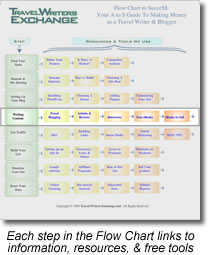If you’re wondering what this Case Study is all about, please read the introductory post from Week One.
This week we’re moving on to Level 4 of our Flow Chart where we dig into the most important aspect of your travel blog, it’s content. This week, it’s all about the travel writing – blogging, articles, and reviews.
All three are important to incorporate into any travel blog, because each serves a different purpose, and all three attract site visitors. Attracting site visitors is a lot like fishing – you use different bait to catch different types of fish, and you use different content to attract different types of readers.
Suzy is already doing a great job with writing reviews, since she’s been a travel writer for many years, and her reviews are published regularly in a number of different online and offline publications. But, like many travel writers, she wasn’t clear on the key differences between blog posts, articles, and reviews. You’ll see these three terms used interchangeably, and for the most part it’s not inaccurate to do so as they are tightly related and share some overlapping properties.
However, there is a subtle difference between them, having to do with the timeliness of the topic, the nature of the topic, and the length of the piece you’ve written.
Travel Blogging and Article Writing

Blog posts are intended for information that is not only informative, but timely…..say for example you want to let your readers know about an event (either beforehand, so that they can attend, or afterwards, as you write about it), or a limited-time product offering, or a recent trip. Blog posts speak about your experience.
Articles, on the other hand, are intended to educate your audience about something which you are knowledgeable about — things that are both timeless and advisory. If you’re a traveling backpacker, you might write a blog post about your last weekend hike. You might also write an article about how to prepare for a successful backpacking trip, with tips about what is most critical to pack for a week-long hike, to help an inexperienced backpacker avoid mistakes. If you’re a frequent traveler to Italy, you might write a blog post about your last trip to Rome, or an article on how to tour Italy on $10 a day or less.
Another key difference between blog posts and articles is the length – a blog post is typically around 300 to 500 words. If you regularly write very long, rambling blog posts you will limit your audience to those people who have a lot of time on their hands and not much else to do, and your mom, of course, who will read everything you write and declare it the most brilliant thing she’s ever read (thanks mom!). If you have written a longer piece that you also think is brilliant and you just can’t bear to edit anything out, consider breaking it into a “series” that you post over a number of days or weeks, rather than all at once. Articles can be longer because readers typically have more patience and a greater attention span if they are learning something of value to them.
Reviews
You can review anything – a product, place, or event, but generally speaking a “review” piece differs from a blog post when it goes into greater detail, and is written FOR the reader, not ABOUT the writer. For example you might write a short blog post about the great time you had at a particular place – is it about you and the great time you had? Then it’s a blog post. If you focus instead on the place and everything about it that a reader might want to know, and either leave out or only mention in passing the great time you had there, then it’s a review.
Travel writers commonly fall into two groups: Old School (travel writers who focus on destination-specific information-packed reviews, also known as as “service pieces”) and New School (travel writers who focus on narrative storytelling, essays that feature a destination). New School travel writers will sometimes, with just the barest *hint* of derision in their voice, refer to reviews as “brochure writing”.
However, reviews are still a very powerful way to attract readers to your travel blog. Witness the extreme popularity of, and large quantity of site traffic to, travel review sites like TripAdvisor, Yahoo! Travel, IGoUGo, and many others of that genre. Travelers WANT to know as much as possible about destinations before they go there.
Reviews are where Suzy really shines – she chose as her travel niche a specific type of travel, rather than a place, so she’s busily writing a number of reviews of various destinations that cater to this specific type of travel.
If you’ve chosen a specific destination for your travel blog, you should definitely be including, or better still focusing on, reviews of the various hotels, dining establishments, and entertainment opportunities available to travelers at that destination. Remember, the goal here is to earn revenue from your travel blog, and to do that you need to first attract a lot of site visitors. People who arrive at your site while researching information for a trip will be much more predisposed to be intrigued by what you offer – including ads for relevant products and services – than someone who came to read a lovely, lyrical, essay.
By all means if your heart sings those narrative tales to you, write and publish them. Just don’t forget about what draws the highest number of visitors to your site.
Next week we’ll explore other creative ways of adding good, relevant, and interesting content to your travel blog, such as interviews (both giving and receiving) and guest blog posts, as well as methods and tips for keeping that creative inspiration flowing – stay tuned!
~Trisha
What type of travel writing to you do? Share your experience!






I think it’s a good idea for travel writers to stretch their writing with articles. These days everyone has a blog, but writing an in depth article could get you a job at your favorite publication. It helps to narrow down you niche so you can focus. This is something I am working on right now. It’s like that saying, “…you can’t be everything to everyone.”
I read this twice and now feel like I understand the difference between blog posts and articles, but still not sure if articles are intended to be submitted elsewhere, not on your blog?
Hi Jennifer
Articles can be published both on your blog AND elsewhere, you just need to be aware of any policies or guidelines of the publications (online or offline) that you want to submit it to – some require exclusivity, others just require it to be a certain % different to avoid duplicate content issues, still others don’t care, but you’ll want to know this before you post it to your site.
Some article marketing gurus will advise you to put a modified (“lite”) version out for syndication, with enough information to be helpful, but leaving the reader wanting to know more. This version should direct readers to a more expanded version at your site.
I know this method CAN work well, but it depends upon the article itself – the quality of the information in both the lite and expanded versions.
I hope this helps! Feel free to post this question in the forums where you may get some additional opinions.
I have to confess, I’m one of those “new school” travel writers who has looked down my nose at the old-schoolers. I’ve deliberately avoided doing reviews (except for a few when I first started out) because I discovered travel essays and fell in love with that style of writing, deciding it was the “best” type of travel writing.
But I’ve been giving this a lot of thought since you came out with this post last week – and I’ve come to the realization that I was writing only for myself – or for those I imagined (assumed?) were reading what I wrote to be “transported”, and not for anyone who might stumble across my site looking for information.
I still would probably have not considered writing reviews again, except one line from your post has haunted me – “Travelers WANT to know as much as possible about destinations before they go there” – it’s what I’ve been thinking about most this week – who are travel writers writing for, if not for the travelers?
Thanks for opening my eyes, and I’m looking forward to reading some of the prior installments, as well as the next one.
Sorry about the anonymous thing, but I’m a little embarrassed by my prior snobbish attitude.
@Anon – as you probably already know from the email I just sent to you, I’m deeply grateful that you took the time to offer this feedback.
This past week I’ve been really stressing over the low quantity of comments on this post (the fewest ever) and worried that it was because I’d offended a lot of readers, even though I’ve encountered quite a number that do make fun of “reviewers” (their words) and felt that I was just being truthful.
And maybe I did offend a few writers, but a lot of beginning travel writers need to know that reviews are still a very powerful tool and still a good way to get published, so they should not let anyone make them feel like it’s beneath them.
I overheard a writer at a conference use these exact words in conversation with a couple of others, “it doesn’t take any talent to write service pieces” (aka reviews)….it bothered me since then that I didn’t speak up and correct that person, so I felt it was important to include my view in this post.
I’m sincerely glad it made you stop and think.